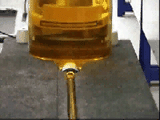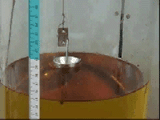| 10 | Discharging oil tanks (laminar flow) |
|
|
| Main | Oil is drained from a cylindrical tank through a horizontal glass pipe fitted at the bottom of the tank. Data of the oil level is taken as a function of time. More…
 
|
Photographs |
|
| Movies | |
| Data files | |
| Models | |
| |
| Sections | |
|
| |
| Description | DESCRIPTION OF EXPERIMENT |
| Experiment |
|
| Dimensions |
|
| |
| Sections | |
|
| |
| Assignment | A POSSIBLE PATH THROUGH THE INVESTIGATION… |
| Basics | |
Particulars |
|
| |
| Sections | |
|
| |
| Model | MODEL EQUATIONS AND MORE… |
| |
|
| |
| Sections | |
|
| |
| Questions | SOME SIMPLE QUESTIONS… |
| 1 | Draining oil from a straight-walled tank through a horizontal pipe at the bottom is expected to lead to an exponentially decaying oil level. How would you test data for this expectation? (Data) |
2 | For the set of data presented in the Data file, estimate how long it takes for the level to decrease to half of its initial value. Repeat the estimate by starting at t = 100s, and again by beginning at t = 150 s. Do you get the same results? |
3 | How do you determine the pressure of the oil at the bottom of the tank? Is this pressure a linear function of the volume of oil in the tank? |
4 | How could you determine the flow of oil through the pipe? |
5 | It is possible to identify two pressure differences. The first is leading from the surface of the oil in the tank to the inlet of the pipe (where the pipe is attached to the tank), the other is leading from the inlet to the outlet of the pipe. What can be said about the relationship between these two pressure differences? |
6 | What do you expect to happen to the level of oil as a function of time if you increase or decrease the length of the horizontal pipe by a factor of two? Do the experimental results support your idea? (Data) |
7 | What do you expect to happen to the level of oil as a function of time if you increase or decrease the radius of the horizontal pipe by a factor of two? How do you use Data to test your idea? |
8 | Assume the current of oil through the pipe to depend upon the pressure difference along the pipe. What form of this relationship leads to a rate of change of level of oil in the tank proportional to the level itself? |
|
| |
| Sections | |
|
| |

